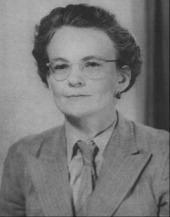Nationality British Role Astronomer | Name Elizabeth Alexander | |
 | ||
Born December 13, 1908Merton, Surrey, UK ( 1908-12-13 ) Children Bill AlexanderMary HarrisBernice Jones Alma mater Newnham College, Cambridge Fields Geologist, Radio astronomy | ||
Frances Elizabeth Somerville Alexander (née Caldwell; 13 December 1908 – 15 October 1958) was a British geologist, academic, and physicist, whose wartime work with radar and radio led to early developments in radio astronomy. Alexander earned her PhD from Newnham College, Cambridge and worked in Radio Direction Finding at Singapore Naval Base from 1938 to 1941. In January 1941, unable to return to Singapore from New Zealand, she became of Head of Operations Research in New Zealand's Radio Development Lab, Wellington. In 1945, Alexander correctly interpreted that anomalous radar signals picked up on Norfolk Island were caused by the sun. This interpretation became pioneering work in the field of radio astronomy, making her one of the first women scientists to work in that field, albeit briefly.
Contents
Biography
Alexander was born Frances Elizabeth Somerville Caldwell on 13 December 1908 in Merton, Surrey. She spent some of her early life in India, where her father, Dr. K. S. Caldwell, was a professor at Patna College. (He was later principal of Patna Science College after its founding in 1928). In 1918, Alexander returned to the United Kingdom and began secondary school. She went to Newnham College, Cambridge to study natural science, initially focusing on physics, graduating with First-class honours in 1931, then completing a PhD in geology for a thesis on Aymestry Limestone, under the supervision of Owen Thomas Jones. Like all women graduates of Cambridge University at that time, she could not become a full member of the university until after equal rights were granted post 1945.
In July 1935, Alexander married a physicist, Norman Alexander, from New Zealand. When her husband took the post of Professor of Physics at Raffles College in Singapore, Elizabeth Alexander began a study into the effects of weathering in the tropics. Whilst in Singapore, the couple had three children, William in 1937, Mary in 1939 and Bernice in 1941. On 4 January 1942, under Navy orders to take her children to safety and return with specialist equipment being made in Australia, Dr. Alexander and her children were evacuated to New Zealand by a Short S23 C flying boat. After the Fall of Singapore on 15 February she was stranded in New Zealand with no news of her husband for six months, then the inaccurate information that he was dead.
In reality, he had continued as Scientific Adviser to the Armed Forces, moving to help out at Singapore General Hospital when Raffles College was on the front line. At the hospital, he kept the X-ray machines going until Singapore fell a few days later. He was then interned in Changi, then Sime Road camps, along with the senior medical staff of the hospital. In September 1945 he was reunited with his family in New Zealand for six months compulsory sick leave, returning to Singapore in March 1946 to restart both Physics and Chemistry Departments at Raffles College. Both departments had been looted and the Professor of Chemistry and his senior lecturer were both dead. Dr. Elizabeth Alexander wound up her work in Wellington and took her children to England, leaving them with her sister as guardian. She rejoined Norman Alexander briefly in England to buy equipment for the College, before they returned to Singapore together. She then took up the post of Government Geologist, restarted her work on tropical weathering and acted as registrar for the conversion of Raffles College to the University of Malaya.
Over the next two years, Norman Alexander spent time in both Singapore and New Zealand, whilst Elizabeth Alexander returned to England. In 1947, when the children were old enough to attend boarding school, the couple returned to Singapore, both working at Raffles College. In 1952, the couple moved to Ibadan, Nigeria, both accepting posts at University College Ibadan. Norman became the Chair of Physics, whilst Elizabeth took on the role of Lecturer in Soil Sciences. She worked in Agronomy, soil science, and administration. The university opened a department of geology in 1958 and appointed Dr. Elizabeth Alexander Senior Lecturer and Head of Department. Just three weeks into her new role, Alexander suffered a stroke and she died a week later on 15 October 1958 at the age of 49.
Wartime work
Between 1940 and 1941, Alexander held the rank of Captain in the Naval Intelligence Service, working on radio direction-finding at Singapore Naval Base. She became Senior Physicist and Head of the Operational Research Section of the Radio Development Laboratory in Wellington, New Zealand in 1942, where she remained until 1945. There she was responsible for most radio and radar research, including pioneering of radio meteorology in conjunction with Washington State College, development of the microwave radar program, and research on anomalous propagation leading to the post-war international project, Project Canterbury. In 1945, Alexander identified the "Norfolk Island Effect" as solar radiation, confirming that solar interference increased with sunbursts. This discovery marked the beginning of Australian radio-astronomy after she left New Zealand when her contract ended with the end of the war in 1945. There has been some debate over whether Alexander or Ruby Payne Scott was actually the first woman to work in the field of radio astronomy.
Despite her progress in the field, Alexander only ever considered radio astronomy a job and as soon as the war was over she returned to her passion of geology, never again working in radio astronomy. Alexander became the Geologist to the Government of Singapore in 1949, responsible for surveying the island and went on to publish a report in 1950 which included the first geological map of Singapore.
